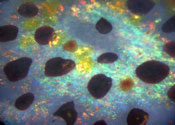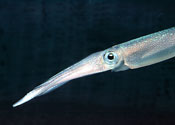 |

For further MBL News and Media Information, contact the MBL Communications Office at (508) 289-7423 or e-mail us at comm@mbl.edu
For Immediate Release
September 20, 2006
Contact: Gina Hebert
Tel: 508-289-7725; Cell: 508-717-1730
ghebert@mbl.edu
Squid Skin Reveals Hidden Messages
MBL scientists find anatomical evidence for a hidden communication channel that remains masked during camouflage
MBL,WOODS HOLE, MA—In the animal world, squid are masters of disguise. Pigmented skin cells enable them to camouflage themselves—almost instantaneously—from predators. Squid also produce polarized skin patterns by regulating the iridescence of their skin, possibly creating a “hidden communication channel” visible only to animals that are sensitive to polarized light... More>>>
Resources:
"Anatomical basis for camouflaged polarized light communication in squid"
Lydia M. Mäthger and Roger T. Hanlon
Download PDF of paper [here].
High-Resolution Images:
Please click on thumbnails for high-resolution images
 |
|
 |
|
Figure 1:
|
|
Figure 2:
|
|
Squid have two distinct layers in their skin: superficially located chromatophores (pigment organs) and underlying iridophores (reflector cells). Iridophores can be covered within a fraction of a second by chromatophore organs during camouflage. Both images above show the same iridophore splotch with yellow chromatophores retracted (Figure 1) and expanded (Figure 2) over polarized iridophores. Mäthger and Hanlon found that when chromatophores expanded over polarized iridophores, the chromatophores acted like a filter in the squid’s skin, altering the color of light reflected from the underlying iridophores, yet not depolarizing the light passing upward through the pigmented chromatophores. Photo credit: Lydia Mäthger
|
|
 |
 |
 |
 |
Figure 3:
|
|
Figure 4:
|
Loligo pealeii (Longfin inshore squid) Photo credit: Roger Hanlon
|
|
Links:
|